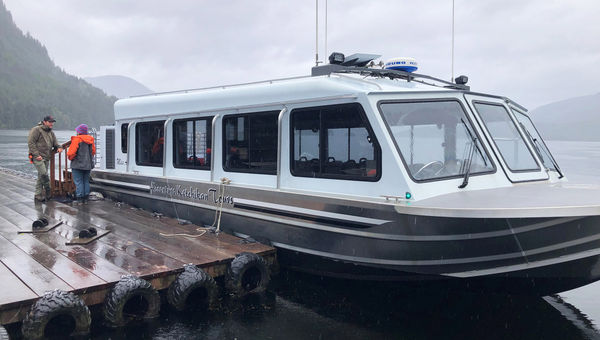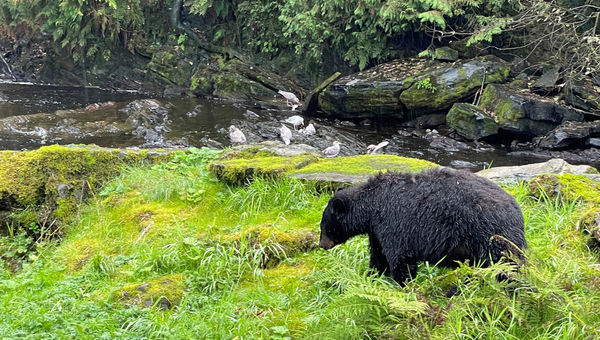NEET'S BAY, Alaska -- Most people come to Alaska to see three things: glaciers, whales and bears. Of those three, bears are typically the hardest to find.
So when I heard that this excursion out of Ketchikan practically guaranteed a bear sighting, I knew I wanted to go.
We filed off the Regent's Seven Seas Explorer and onto a bus at the Ward's Cove cruise pier north of downtown for a short ride to a dock where we boarded a jet boat operated by Adventure Ketchikan Tours. From there it was an hour's ride to our bear-watching area.
That's part of the reason a bear sighting was likely. The destination was remote from any real habitation. The other reason was that it was located on a bay where a whitewater stream meets ocean waters. That means that the bear's favorite food, salmon, would be trying mightily to get upstream to spawn, thus making easy fishing for bears.
First, a little background
Our guide on the tour gave us first-rate background on fish, bears, Alaska history, explorer George Vancouver's contact with the natives in the area and other matters. One of the most intriguing subjects was the little-known U.S. Navy installation in the Behm Canal near Ketchikan.
We passed by the base, formally known as the Southeast Alaska Acoustic Measurement Facility, which consists of two barges and a subsurface electronic array, which are used to build noise profiles of U.S. nuclear submarines.

An Adventure Ketchikan Tours jet boat used to ferry excursion passengers to the Neet’s Bay Hatchery in Alaska for bear watching. Photo Credit: Tom Stieghorst
Anything that can make submarine noise, down to a faulty fan on a refrigerator, can be detected and fixed there. It was a nice bonus to the tour, but most of the 30 people on the boat were eager for the main event.
We arrived at the Neet's Bay Hatchery dock and trooped off, following a muddy path along the shore that led to the stream. Along the way, we were shown trees where climbing bears had left large gash marks and subterranean dens where they seek shade and shelter from other bears.
Seafood buffet
I had somehow expected to wait for bears to appear at the site, but when we arrived, there they were: a pair of 350-pound black bears midstream, peering into the rushing water for a shot at their midday meal.
A rope line strung between two viewing platforms kept us about 20 yards from the stream. Bears feed on spawning salmon from late July to late September, and one nice thing about it is that they aren't too interested in humans while the buffet is open. Nonetheless, our guide carried bear spray in case something rare occurred.
To be clear, this wasn't like some adventure photos I'd seen where 20 or 30 big brown bears sit amid the rocks and rapids. We saw a total of four bears over the course of a rainy hour. But on a previous Alaska trip I had stood for 45 freezing minutes on a platform in the gloomy twilight without seeing a single bear.
It was only after we got in the van back to our base that we saw a fat, brown mama bear hustling off the road into the trees.

An Alaska black bear approaching a stream at the Neet’s Bay Hatchery north of Ketchikan. Photo Credit: Tom Stieghorst
Just when you start to think the bears are pretty bad at fishing, they suddenly have one in their jaws. Our bear took his catch over to a rock for dismemberment, which took about five minutes.
Some bears catch and release male salmon, looking only for the females full of roe, which provides the most fat for the least work. (Black bears need to gain about 200 pounds to comfortably hibernate through the winter.)
The Neet's Bay Hatchery was built here to help ensure that as many salmon fry as possible survive to sustain the species. Workers harvest the eggs, fertilize them and raise the fish to a decent size, avoiding the loss to birds, other fish and drought that otherwise reduce a naturally bred salmon population.
We saw no whales on our trip back to Ketchikan but did pass by a collection of rocks where 1,500-pound Steller sea lions were playing king of the hill.
Everyone on the jet boat was gratified to have seen Alaska bears in the wild, feeding on their favorite food. But for myself, and perhaps others, I was also looking forward to a change of dry clothes and a hot beverage to punctuate my successful bear outing.